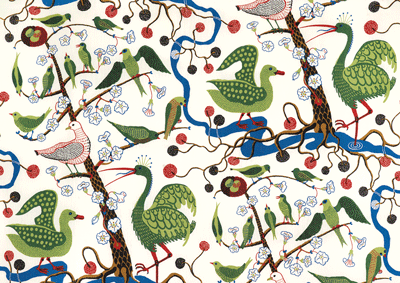Furniture and textiles from the Austrian Jewish designer are a visual treat for Swedes, Jews and all Minnesotans
By DORIS RUBENSTEIN
The entrance hall of Minneapolis’ American Swedish Institute (ASI) is mind-boggling for its ornate woodcarvings and breathtaking stained glass window. As I descended the stairway to the small basement gallery, my eye was startled in an entirely different way — bursts of color, light and pattern bombarded me from all directions.
We can thank the ASI curatorial staff for this treat, and we must praise designer Josef Frank for these delightful creations. It’s hard to be unhappy when surrounded by Frank’s work.
Frank (1885-1967) was born to middle-class Jewish parents in Vienna, but thanks to his Swedish wife, he was embraced by the Swedes as one of their own. Frank came to design genetically and environmentally — both of his parents were engaged in design and decorative enterprises as owners of a textile factory. But Frank went one step further by studying architecture as well.
Clearly, Frank was a secular Jew and there is virtually nothing identifiably Jewish in his portfolio, but this could not save him from the Nazi onslaught. Frank and his wife, Anna, recognized this early and took advantage of an employment opportunity to move to Stockholm in 1933, where Frank worked with the design firm of Svenskt Tenn. They were obliged to flee again in 1940, this time to New York City, and it is this period that is best represented in the ASI show, The Enduring Designs of Josef Frank.

While living in Manhattan, Frank drew from American field guides such as The Red Book of Birds of America to create “Green Birds” (above) and many of his other New York patterns. Some of the birds depicted include doves, ducks, parrots and starlings in the treetops. The large “blue” heron, colored green in Frank’s pattern, sits in a mangrove-like Tree of Life. (Photo: Josef Frank / Courtesy of Svenskt Tenn, Stockholm, Sweden)
Those enduring designs from the 1920s through the 1950s would be as welcome in a contemporary home in North Oaks or Wayzata today as they were in Stockholm when they first were produced. Indeed, many of Frank’s textiles are still in production by Svenskt Tenn.
Frank makes bold statements in his textiles, using primary colors and often contrasting with white or red backgrounds. His whimsical depictions of animals and birds in stylized naturalistic settings betray the fact that Frank made extensive use of biological resources, such as Audubon’s Birds of North America or the Trees of North America field guide, to inform his designs.
In “Green Birds,” we see a duck whose mere suggestion of a smile cannot but bring a similar response to our own lips; the same can be said of a singing and dancing heron. The parrots in “Himalaya” gaze at you with curiosity and just the hint of a twinkle in their eyes.
The designer ventured beyond the concrete streets of Manhattan to explore other American themes and incorporate them into his work. “Vegetable Tree” is a Tree of Life where everything tasty-looking and tempting grows. Hanging from the branches, enticing our fingers to pluck them and pop them into our mouths, are strawberries, pomegranates, pears and eggplants. His “Armchair with Dixieland” uses water themes from the Gulf of Mexico, along with symbols of the cultural and commercial connections of New Orleans, with South America and the Caribbean in both the chair’s construction and its upholstery.
Examples of Frank’s furniture in the show demonstrate his appreciation of the eclectic. The style — drawing and sharing inspiration from the craftsman, classic oriental and even Shaker traditions — is now known as “Swedish Modern.” His palate of materials is vast. A chest of drawers on slender, tall legs is cut, smoothed and polished from a walnut that looks more like tiger maple, but for the color; Frank’s undulating carving on a mahogany chest is then polished and varnished to fool the eye into believing that the cabinet has been painted red.
In addition to fabric upholstery, he uses bamboo and rattan on arm and side chairs to add visual interest and additional structural strength to their wooden simplicity.
The Swedish Jewish population of Minnesota can likely be counted on one finger for sure, and possibly be extended to one hand. Little matter. The Enduring Design of Josef Frank is worth a visit by all who are interested in excellence, be you Jewish, Swedish or just plain Minnesotan.
The Park Avenue museum is currently being expanded. Don’t let the construction dust deter you. Ample parking is available.
***
The Enduring Design of Josef Frank is on display through July 8 at the American Swedish Institute, 2600 Park Ave., Minneapolis. For information, call 612-871-4907 or visit: www.asimn.org.
(American Jewish World, 6.22.12)



















